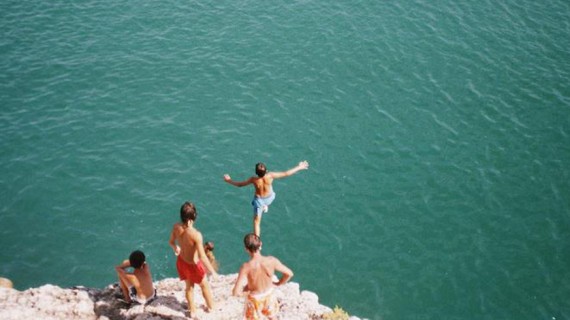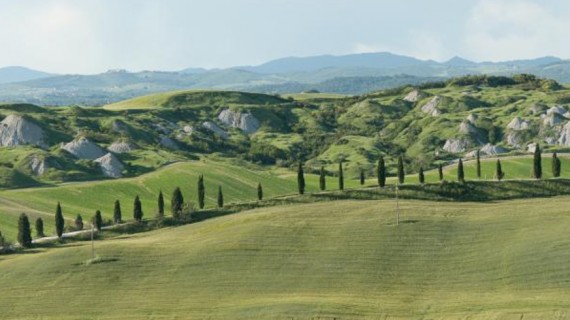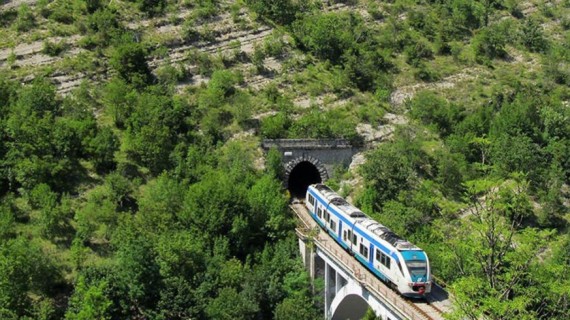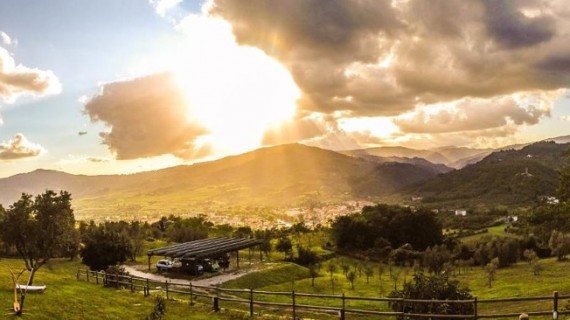Via degli Dei is one of the most beautiful walking tours in Italy, which goes from Bologna to Florence. Find out how to follow this itinerary on foot in 5 days, walking from Emilia Romagna to Tuscany.
What is the Via degli Dei?
It’s a 135 km long trekking itinerary from Piazza Maggiore in Bologna to Piazza della Signoria in Florence. The path takes trekkers through the arcades of Bologna, the breathtaking landscape of the Tuscan-Emilian Apennines with its small villages, and concludes in the UNESCO heritage site of Florence.
Even though it’s called the “Way of Gods,” it’s a non-religious route. The name itself comes from the trail crossing mountains and locations with names of ancient pagan deities. Namely Monte Adone, Monzuno (Mons Iovis, Mount of Jupiter), Monte Venere, Monte Luario (Lua was the Roman goddess of atonement).
The trail was inspired by a group of Bolognese walkers from the CAI Association. Their goal was to travel to Florence and enjoy a delicious Florentine steak. It was in the goliardic spirit of those who walk to enjoy life’s little pleasures and the journey.
Additionally, it is also a historical route, an ancient road that the Romans used, called Flaminia Militare. It was recovered around the ’90s during archaeological excavations, revealing traces of ancient Roman roads connecting Felsinea (Bologna) to Fiesole.
I would like to take you through my journey and show you all the amazing gems that can be found along the way. On the Via degli Dei website, everyone can find the official itinerary of 6 days. It’s possible to do it in 4, 5 or 6 days depending the amount of way one would like to do. We decided to do it in 5, and we divided the 135 km in the following way:
Day 1 Bologna – Brento
The route starts at Piazza Maggiore in Bologna, and the first challenge begins immediately: ascending to the Sanctuary of San Luca under the porticos and up its stairs, covering about 3 km. At the Basilica, we obtained our credentials and started to ascend into the Apennines.
The first day’s main challenge is climbing Monte Adone. As we get closer and look back, the basilica can still be seen in the distance. Brento is situated just under Monte Adone, so luckily after the mountain, it’s easy to reach the accommodation. We chose a bed and breakfast, but there are campsites as well in the village.
Day 2 Brento – Madonna dei Fornelli
The second day’s trail continues through beautiful landscapes with hills and fields until Monzuno. In this village, there are small supermarkets, bars, and a fountain as well to fill up water bottles. I suggest entering Bar Posta in the center and asking for a stamp for your credentials and to see their impressive coffee cup collection.
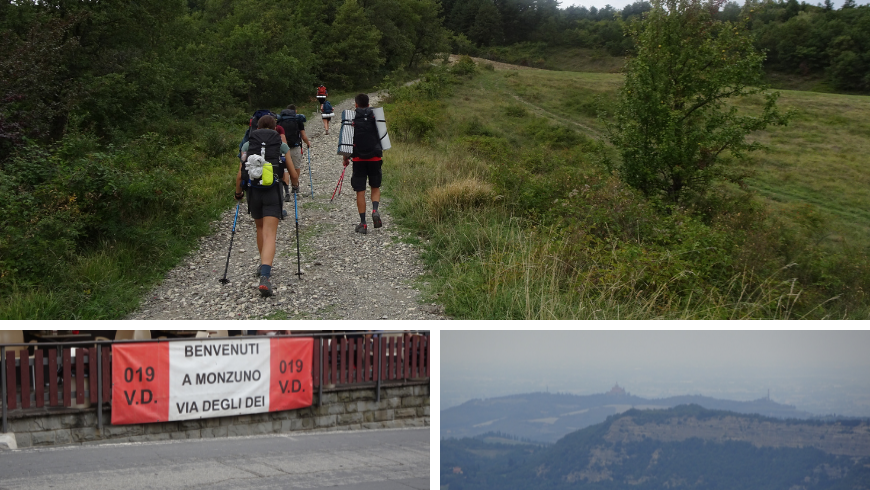
Moving on, the trail passes ‘Le Croci’ peak, which is a perfect place to rest. The trail crosses a beautiful land full of chestnut trees and also a TV tower. It can be seen later several times from a far distance, realizing how much one had actually covered.
The end of this day can be the town of Madonna dei Fornelli. There are campsites, B&Bs, and restaurants as well, but we chose a ‘rifugio’ in the middle of the woods just before Pian di Balestra, so we still had to make our way there.
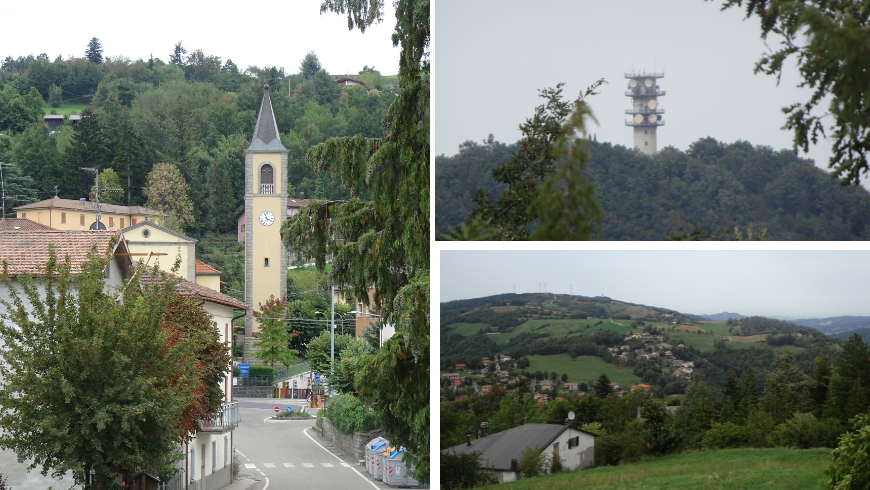
Day 3 Madonna dei Fornelli – Sant’Agata
Our third day started in the foggy woods as we crossed the border between Emilia Romagna and Tuscany. Here there is a part of the old Flaminia Militare with its original stones. Moving on we climbed up to the highest point of the Via degli Dei, the ‘Banditacce’ peak.
Nex at the Passo della Futa we discovered in the fog the German Military Cemetery of the Futa. Going onwards, the trail was full of descents and ascents.
Upon arriving to the other side of the mountain to Sant’Agata, the weather gifted us with the sun and a rainbow.
Day 4 Sant’Agata – Bivigliano
The fourth day is full of Tuscan landscapes. Shortly after Sant’Agata, there is the village of San Piero a Sieve. It has a small but lovely center and a supermarket as well, which can be very useful. This piece of the trail is spent on gravel roads between olive groves and vineyards, seeing the first Florence street sign and feeling the tiredness. Before arriving at Bivigliano, we worked our way up to the Convent of Montesenario. It’s possible to get a stamp and to take a quick break.
Day 5 Bivigliano – Florence
Our last day started with arriving at a point where it’s possible to first see Florence in the distance; this definitely gives motivation to go on and complete the day.
As we arrived at Vetta Le Croci, unfortunately as we entered the woods again, we were walking under the pouring rain through steep uphills and descents until we got to Fiesole. Before arriving in the center, a beautiful view of Florence unfolds before our eyes.
After a quick lunch break in Fiesole, we finally arrived in Florence and crossed the city to arrive in front of the Palazzo Vecchio. Inside there is a welcome center, where all the participants are eligible to get a gadget if they show their credentials with all the collected stamps.
Conclusion of the Via degli Dei
Whether you’re an experienced hiker or just looking for a unique way to experience Italy, this trail will leave you with memories of a lifetime. The path is well-marked, with arrows and stickers showing the way, making it clear and comfortable for hikers. The best seasons to complete this trail are around spring and autumn when the weather is favorable (if you’re lucky), and the landscapes are the most vibrant. Regarding accommodations, there are several agriturismi, bed and breakfasts, and rental rooms along the route that provide comfortable stays, each with its unique character. An important, if not the most important part of this experience is meeting like-minded people along the way and sharing these memories and experiences with them.
The Via degli Dei is truly a great experience both physically and mentally. Crossing through two beautiful regions and getting to know them on a deeper level is not a given while traveling in other ways. Hiking and following these kinds of itineraries are a great way to travel sustainably and appreciate the small beauties of the destinations.
Photos by Viktoria Szabo

